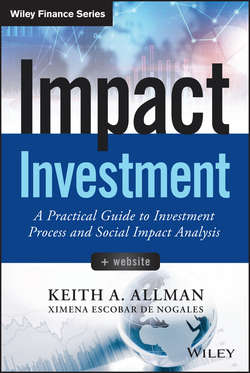Читать книгу Impact Investment - Allman Keith А. - Страница 8
На сайте Литреса книга снята с продажи.
Chapter 1
Introduction to Impact Investing
Who Makes Impact Investments?
ОглавлениеAs we will come to learn later in this book, no other field within finance has a greater disparity of participants than those found to be impact investors. Impact investors differ from traditional investors in a number of ways, but the most important differences relate to return expectations, investment holding periods, and investment motivation. To understand this varied landscape, we should start by looking at some of the oldest impact investors, government institutions.
The International Finance Corporation (IFC), a member of the World Bank Group, is one of the oldest, largest, and best-known impact investors. It invests in a large range of projects, from direct and indirect private equity investments to large-scale infrastructure projects. It would be considered a government institution because it is funded by World Bank member countries. There are a number of other large-scale government funded impact investors, such as IFC, Norway's Norfund, and the UK's CDC Group. The key to these types of investors is that they have a specific mission and seek commercial-style investments, but have a very low cost of capital and longer holding periods than average, which allows them to make investments that strictly traditional investors may not make.
Similar to government-funded investors, in terms of low capital cost and long investment time horizons, are charitable organizations that make impact investments. These organizations can range from nonprofit institutions that use donation money for investment, like Acumen Fund or EnterpriseWorks/VITA, a division of Relief International, to organizations such as Soros Economic Development Fund, which utilize funding from profitable private-sector enterprises to make impact investments.
In the middle of the range of impact investors are high-net-worth individuals who provide their own capital directly into social enterprises. Often they will provide catalytic capital to early-stage ventures or fund business plans that materialize into companies. Similar to the other types of investors already mentioned, these investors have long investment time frames, low costs of capital, and personal motivations for investment that afford them a high degree of flexibility.
Finally, we move up the scale of commerciality to for-profit investors such as GrayGhost Ventures, DBL Investors, and Bamboo Finance. Each of these institutions has a varying commercial approach toward impact investing, where returns and investment horizons are more in line with traditional investors.
